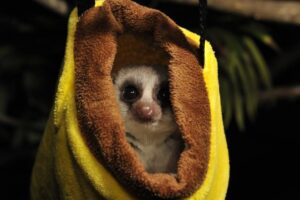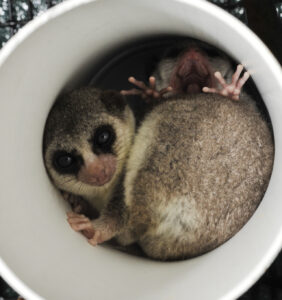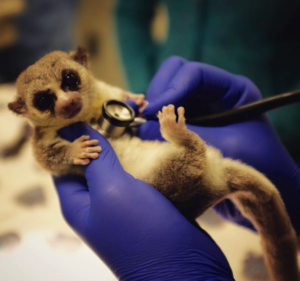This article was written as part of the DLC’s Learning Lemurs Education Subscription program, in which subscribers receive a monthly e-newsletter featuring video clips, activities, and articles on fascinating topics—like torpor! To learn more, please visit our Learning Lemurs homepage.
Deep in the forests of Madagascar, in a hole in the ground or in the hollow of a tree, a creature burrows; its eyes closed, its head tucked under its thick, furry tail, its breathing barely, barely noticeable—is it even breathing at all?

DLC animal care technicians provide a variety of soft beds for dwarf lemurs during torpor. This particular bed is shaped like a banana, one of the fat-tailed dwarf lemur’s favorite pre-torpor snacks.
In the midst of their hibernation season, fat-tailed dwarf lemurs might breathe only once every 10 minutes, their heart might beat only six times per minute, and their bodies may cool down to match the temperature around them. These small Malagasy lemurs may appear to not be alive at all, but in fact they are deep in a torpor state, relying on their stored body fat to keep their bodies alive in a state of suspended animation. While the nine recognized species of dwarf lemur vary in weight, ranging from about 4-10 ounces, they will all nearly double their body weight prior to the hibernation season by storing fat in their tails (though only the one species claims that particular name). That namesake of a tail will add up to 40% of the lemur’s total body weight when they are fully prepared for the torpor season. In order to store the amount of fat necessary for their metabolic shutdown, dwarf lemurs will gorge on fruits, nectars and occasionally insects during the wet season in Madagascar, when food is plentiful.

A pre-torpor fat-tailed dwarf lemur tail, full of nutrients to get them through hibernation!
It may seem surprising that a member of the primate family living in a tropical area would need to hibernate, but while temperatures do not typically drop below 40° Fahrenheit during Madagascar’s dry season, periods of drought will result in a lack of food resources, creating a need to conserve energy. Out of all 100 or so lemur species living in Madagascar, dwarf lemurs are the only primates known to truly hibernate, though their close relatives the mouse lemurs can experience short bouts of torpor as well. While there are nine dwarf lemur species, it is unclear if all of them hibernate in the same way that the fat-tailed dwarf lemurs do. During the hibernation period, which can last up to seven months, the dwarf lemur alternates between periods of torpor, which are defined by decreased metabolism, heart rate, and body temperature, and periods of intermittent arousal, during which the lemur will return to normal heart rate and body temperature, and typically catch up on sleep. Intermittent arousal typically occurs every 6-12 days during the hibernation period, and lasts around 24 hours.

Animal care technicians provide the fat-tailed dwarf lemurs with many snuggly spots for their torpor. PVC tubes are a lemur favorite!
Because most dwarf lemurs will hibernate inside of tree holes or underground in order to remain hidden from predators and to regulate their body temperature, they are also difficult for researchers to find in the wild. Imagine searching an entire forest for an animal not much bigger than a hamster, burrowed somewhere underground, not moving, not making a sound… it’s tough enough to track a dwarf lemur when they’re awake, let alone hidden away in their hibernation hole! Field researchers may utilize radio tracking collars to monitor the dwarf lemurs’ whereabouts, including where they go to forage during the wet season. Once the dwarf lemurs are located, scientists can non-invasively take measurements of the animal’s weight, body temperature, heart rate, and other data to add to our understanding of torpor behavior in the wild. However, there are many things that might be difficult to ascertain in a study of wild dwarf lemurs. Things like baseline weight, specific diet, and even individual life histories may not be possible to know in a wild study. Knowing important variables like these can help scientists understand more about the specific body changes occurring during torpor, and the reasons for those changes.

Marina Blanco (right) places a radio collar on a wild fat-tailed dwarf lemur.
Now imagine that instead of searching for a small lemur buried deep in their hibernation site in the forests of Madagascar, you could study dwarf lemurs in a controlled environment, where thing like temperature, light, diet, and hibernation spots could be set up specifically to answer your questions. At the Duke Lemur Center, non-invasive research on fat-tailed dwarf lemurs looks just like this. A small group of dwarf lemurs, whose life histories are well-documented, undergo a torpor study in the cozy and specially-designed hibernaculum. Duke Lemur Center research scientists like Marina Blanco can ensure that the conditions in the hibernaculum are ideal for torpor and can even create a specialized menu of pre-torpor diets for the animals to enjoy. Daily measurements like weight, tail girth, heart rate, and other critical data can be taken in a way that is non-disruptive to the hibernating lemurs, and allows for greater understanding of the finer details of this unique metabolic process.

A wild fat-tailed dwarf lemur pokes its out of its tree trunk nest.
Through a combination of field studies and non-wild studies, a great deal has been discovered about fat-tailed dwarf lemurs. Being the only truly hibernating primate makes this little lemur especially interesting to study, as the genome of lemurs is much more similar to the human genome than one of, say, a ground squirrel. Identifying the particular genes that allow for the torpor process to occur in dwarf lemurs, and how those genes are “turned on,” could help us understand whether humans are capable of undergoing a similar hibernation process. This could be beneficial in medical situations, such as long-term treatments or having to wait for an organ transplant. This hibernation state could even take humans farther into outer space than ever before, allowing astronauts to remain “suspended” during long journeys without requiring resources or air. For such a small animal, fat-tailed dwarf lemurs have an exceedingly long life-span—up to 30 years in human care—which could give us some insight into the biological mechanisms that slow down the aging process. Additionally, the ability to switch from extreme fat storage to low metabolic activity could help us learn how to regulate metabolic disorders in humans.

Tottenham receives a post-torpor wellness exam on 2/14/2020 by DLC veterinarian Dr. Laura Ellsaesser. Photo by staff research scientist Lydia Greene, Ph.D.
The incredible potential that lies within the genome of one small primate deep in the forests of Madagascar reminds us how crucial our understanding of the natural world is. Most dwarf lemur species are threatened in the wild, with populations currently decreasing. If we can protect this species from extinction and continue to discover more about their exceptional biology, we may truly reach the stars.

